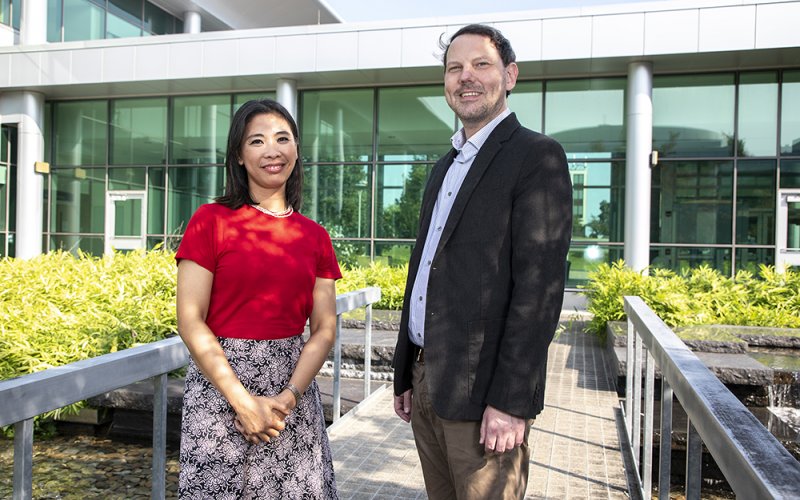Microbiology Research makes Maxi-Gains through Early Stage Investigators’ Success

ALBANY, N.Y. (Aug. 26, 2021) — In an extremely competitive international research environment, a university’s research enterprise must always be building, acquiring new and vibrant talent. In the field of microbiology, UAlbany is witnessing that level of growth in the presence of Cheryl Andam and Alex Valm, assistant professors in Biological Sciences.
Andam, who joined the faculty in Fall 2020, is a microbial genomic scientist working on the evolution and epidemiology of infectious diseases. Department colleague Valm, who came to UAlbany in fall 2017, is a microscopist, studying the spatial relationships of microbes in the mouth. Each, in the broad sense, is an “early stage investigator,” having received his or her highest research degree in the past 10 years.
And each is being amply rewarded for their innovations.
Andam’s latest award is a $1.5 million Maximizing Investigators’ Research Award (MIRA) grant for early stage investigators from the National Institutes of General Medical Science of NIH, which just began on Aug. 9 and runs through June 30, 2026. The project will study the causes, patterns and consequences of genomic recombination in diverse species of bacterial pathogens.
Valm’s most recent grant is barely a month older (July 7), a $1.8 million award from the National Institute of Dental & Craniofacial Research (NIDCR) of NIH, titled “Oral microbial community structure and assembly: from molecule to microbiome.” It also runs through June 30, 2026.
“As a microbiologist myself, I’m personally gratified by the great successes of Cheryl and Alex,” said Marlene Belfort, SUNY Distinguished Professor in Biology. “It’s wonderful to be around them as they employ the most modern molecular and microscopic techniques to study microbes, be they in the body or the biosphere.”
Investigating How Bacteria Evolves
The MIRA grant study by Andam, “Population and evolutionary dynamics of recombining genes and alleles in bacteria,” looks at genetic recombination, a process in which bacteria evolves by exchanging genetic material with other strains and other species. “This allows bacteria to acquire traits that help them adapt in different environments or to respond to their host, such as multidrug resistance and virulence,” said Andam, who noted that this process may be seen in variant strains of the coronavirus.
Her project aims to elucidate why bacteria, even those that are considered the same species and expected to be genetically identical, differ in their ability to recombine. The research has important implications for developing new types of treatment and diagnostics for diseases that specifically target this process.
Getting to the Root of Chronic Dental Problems
Valm’s NIDCR project notes that, just as the function of plant and animal tissues and organs is mediated by the patterned assembly of distinct cells during development, the functions of oral microbes in promoting health and disease arise from the emergent properties of their patterned structure, or “biofilm.” “For example,” he said, “the accumulation of dental plaque microbes into stable, long-range biofilms close to the gum line is implicated in reversible gingivitis, which may progress to chronic periodontitis.”
The Valm Lab’s team of graduate assistants is now creating an in vitro biofilm system. “We are growing dental plaque in the lab,” he said. “I also call this a ‘dental plaque on a chip’ system, or even an ‘artificial tooth.’ We collect dental plaque from healthy volunteers and put this on a glass ‘tooth.’ Then we add some nutrients, and the plaque bacteria grow on the tooth. Because it's glass — actually a microscope slide — we can take it directly to the microscope and take images of the plaque biofilm.”
Valm’s research impacting oral care has resulted in a recent spinoff: a $113,000 grant through 2022 from the Colgate Palmolive Company. One of its research scientists approached Valm after he gave a talk at the International Association for Dental Research meeting in London in 2018. “At that meeting I presented my students' preliminary work to develop the artificial tooth imaging system here in my lab at UAlbany.” He’s also at work on a dental plaque biofilms project funded by the 3M Corporation.
For Andam, the MIRA award is not the first acknowledgement of her early stage research excellence. She is also currently at work on a $1.17 million NSF CAREER award grant from the National Science Foundation, “Unraveling the origins of genomic heterogeneity in microbial species and populations,” received in 2019 when she was on faculty at the University of New Hampshire, with the work now moved to UAlbany and running through June 30, 2024.
“My NSF grant focuses on how the environment and host animal influence genetic variation between bacterial strains,” said Andam. “Determining why genomes within a species vary, and what the consequences of this variability are is important in understanding microbial diversity on Earth.” The study has practical implications for questions about the role of microbes in agriculture and public health.
Attracting a Growing Portfolio of Early Career Investigators
Both Andam and Valm utilize the resources of the College of Arts & Sciences’ Life Sciences Research Building, which houses the RNA Institute, of which the two researchers are faculty. “I am extremely proud of RNA Institute members Alex and Cheryl, who are moving forward with their exciting research programs, newly funded by NIH,” said Andy Berglund, RNA Institute director.
Belfort notes that early stage achievement is being mirrored across life sciences fields at UAlbany. She gave as examples Paolo Forni, Morgan Sammons and Gabriele Fuchs in Biology, Alan Chen and Jia Sheng in Chemistry, and Andre Paolos and Damien Zuloaga in Psychology.
“We are drawing some of the best young research talent,” said Belfort. “The RNA Institute is a big part of the reason why, but also the interactiveness of our students, which has increased over the course of the years. We see faculty and students so excited to be together.” Both Andam and Valm also cited the high level of mentoring and collegiality that they have witnessed at UAlbany.




